食品安全中英文对照外文翻译文献
食品安全与营养外文翻译文献
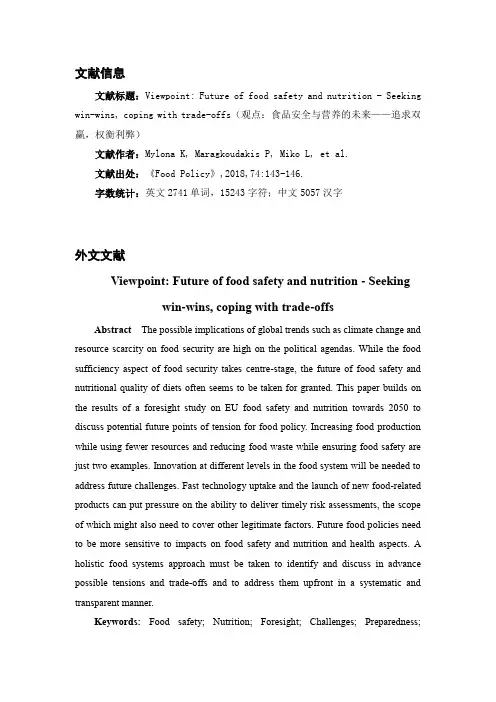
文献信息文献标题:Viewpoint: Future of food safety and nutrition - Seeking win-wins, coping with trade-offs(观点:食品安全与营养的未来——追求双赢,权衡利弊)文献作者:Mylona K, Maragkoudakis P, Miko L, et al.文献出处:《Food Policy》,2018,74:143-146.字数统计:英文2741单词,15243字符;中文5057汉字外文文献Viewpoint: Future of food safety and nutrition - Seekingwin-wins, coping with trade-offsAbstract The possible implications of global trends such as climate change and resource scarcity on food security are high on the political agendas. While the food sufficiency aspect of food security takes centre-stage, the future of food safety and nutritional quality of diets often seems to be taken for granted. This paper builds on the results of a foresight study on EU food safety and nutrition towards 2050 to discuss potential future points of tension for food policy. Increasing food production while using fewer resources and reducing food waste while ensuring food safety are just two examples. Innovation at different levels in the food system will be needed to address future challenges. Fast technology uptake and the launch of new food-related products can put pressure on the ability to deliver timely risk assessments, the scope of which might also need to cover other legitimate factors. Future food policies need to be more sensitive to impacts on food safety and nutrition and health aspects. A holistic food systems approach must be taken to identify and discuss in advance possible tensions and trade-offs and to address them upfront in a systematic and transparent manner.Keywords:Food safety; Nutrition; Foresight; Challenges; Preparedness;Trade-offs1. IntroductionOne of the key questions dominating the turn of this century is how to secure the supply of sufficient, environmentally sustainable, nutritious, safe and accessible-to-all food. Food security ('zero hunger') features very high among the recently agreed 17 Sustainable Development Goals (SDGs) and is intimately linked to several other SDGs (United Nations, 2015). Ensuring food security and a sustainable agro-food system is not an easy task, given the impacts of climate change and the need to reduce greenhouse gas emissions and to preserve key resources of particular importance for the water-energy-food nexus. The increasing global population and the transition in emerging market economies towards diets of predominantly animal origin, put additional pressure on ensuring sufficient food production (Alexandratos and Bruinsma, 2012). We have seen how disruptive events and geo-political developments such as the 2008 economic crisis or the 2015 EU/Russian embargo, which resulted in a 43% decrease of EU agri-food exports to Russia, had dramatic consequences for both food producers and consumers (Szczepanski, 2015). In addition, recent developments such as the decision of the United Kingdom to leave the European Union and the repercussions this may bring to both parties, demonstrate the need to take into account uncertainty in policy design.While access to “safe” and “nutritious” food is integral in the definition of food security, most studies focus on how to ensure the “sufficiency” requirement of this definition. It can be argued that the reason for this is the high level of food safety currently enjoyed in developed regions. The EU in particular takes pride in its food safety legislative framework, which is seen as one of the most advanced in the world. This is achieved through science-based risk analysis based on the precautionary principle and an institutional separation of risk assessment, management and communication. But even in this environment, the occasional food 'crisis' such as the German EHEC O104:H4 outbreak (Robert Koch Institut, 2011), unearths the vulnerabilities of the system. One may also argue that ensuring safety, nutritionalquality, variety and balance of foods and diets as well as the underlying social, environmental and economic determinants, do not receive the attention they deserve in food security studies, as the sufficiency aspect appears to be more pressing. Moreover, the abundant food offer and almost unrestricted access to a large variety of nutritious quality foods in most of the developed countries, result in the skewed view that it is up to the individual to make the right decisions and succeed in life and health. Making nutritious food available does not automatically lead to population-wide healthy diets (Butland et al., 2007). Despite a series of initiatives and action plans towards the promotion of healthier diets and prevention of chronic diseases (High Level Group on Nutrition and Physical activity, 2014, WHO, 2014), achieving health targets such as those defined in the WHO Noncommunicable Diseases Global Monitoring Framework 2025 (World Health Organization, 2015a) proves to be difficult already today.To shed light on possible future challenges, we have analysed whether the EU’s regulatory and policy framework in the areas of food safety and nutrition can ensure “safe food” and “good nutrition” as we look ahead to 2050 (Mylona et al., 2016). Drivers of change (global trade, agro-food chain structure, technology uptake, social cohesion, food values, climate change, depletion of natural resources and world population growth) were combined to create four alternative, plausible and challenging future scenarios (Mylona et al., 2016). While the study was intended to inform EU policies and to complement the recent Fitness Check of the General Food Law (Regulation (EC) No 178/2002), its conclusions are of relevance for almost every jurisdiction.We identified several points of tension where policies or interventions that aim to improve food safety, the diets of populations or food sufficiency conflict with each other. We conclude that a holistic food systems approach must be taken to identify and discuss in advance such tensions, in order to find a compromise between equally important aspects of the food system and accept trade-offs in a systematic and transparent manner. And beyond trade-offs, such an approach could also identify synergies in different policy areas and lead to win-win scenarios. This opinion paperinvites global thought leaders to critically reflect on some of these.2. Compromising food safety for achieving sufficiency?Intensive production systems have soared under the pressure to increase yield. This has been further facilitated by the continuous concentration of the food industry into bigger entities and the economies of scale to reduce production costs. Should this intensification and industrialisation continue – driven by population growth and offsetting losses caused by a worsening climate – many issues may arise.Beyond the biodiversity and environmental effects of the use of a limited number of high-yield species or varieties in intensive farming, these crops themselves are also more susceptible to disease and pests. Fertilisers must be supplied regularly to ensure the necessary high crop yield and the supply and access to these is also finite and complex. Take phosphate (P) as an example; the amount of accessible high quality phosphate rock is low and diminishing fast; risks to animal and human health are associated with the use of low quality P-fertilisers containing worrying levels of heavy metals such as arsenic, cadmium and lead (Jiao et al., 2012). Similarly, the increasing use of antimicrobials in animal farming to prevent the spread of diseases has led to the development of resistant animal and zoonotic pathogens. This resistance may even compromise the effectiveness of antibiotic treatments for different human diseases (ECDC/EFSA/EMA, 2015). The global consumption of antimicrobials in livestock farming is nonetheless projected to rise by 67% by 2030, due to the growing number of animals raised and the continuous shift towards intensive farming systems (Van Boeckel et al., 2015). All these issues need to be looked at closely.Curbing antimicrobial resistance, for example, is already a priority globally (World Health Organization, 2015b) and in the EU as well (European Commission, 2017). Actions taken or being discussed include banning the use of antimicrobial feed additives, rethinking the currently practiced animal husbandry system, enhancing prevention, use of alternative treatments, surveillance and cooperation at international level.3. Stretching the limits to ensure food safety -compromising local food sufficiency?Yet, while efforts to increase food production as described above are most likely to continue, it has been estimated that, worldwide, at least one third of the food produced is wasted (FAO, 2011). This is a crucial issue that is being addressed through the SDGs and also in the EU, with a shift towards a circular economy that has placed waste reduction, recycling and reuse at centre-stage. Technological innovation such as intelligent packaging (time-temperature indicators, freshness indicators) can help supply chain operators to optimise logistics to reduce waste in other steps of the food chain. More can be done at consumer level, as, at least in the EU, more than half of food waste originates at household level (Stenmarck et al., 2016). There may be tensions here too though; population and individual knowledge are crucial for reducing food waste without compromising food safety. And beyond consumers, food and feed safety-related measures should not be placing unnecessary burden on food producers, food chain operators, trade and eventually on food security. Low maximum levels for residues and contaminants ensure a high level of food safety but could be linked to food waste and food security issues at a local level by “legally” limiting the availability of food. Will a time come when such levels of “waste” become unacceptable and trade-offs need to be discussed?In what regards recycling and waste reduction more generally, it is worth noting that (re-)introduction of either food or organic side stream products in the food chain may also lead to food and feed safety concerns and again a balance must be sought. The Bovine Spongiform Encephalopathy (BSE) outbreak is a good reminder of this kind of unintended consequences. Regional food systems, based on a circular economy and self-sufficiency, where 'do-it-yourself' food production and processing niches may be more widespread, appear more vulnerable in this regard. This niche reality may indeed grow further, triggered by factors such as rising food prices or trends for regional or organic products. In such a scenario, emphasis must be placed on the communication of associated risks and the provision of education and best practice guidance to these “prosumers”, and official controls may need to be revisited.On the other hand, novel technologies, ingredients and products can contribute to keeping the system competitive and make it sustainable in times of resource scarcity. However, they could harbour new food safety risks. Risks can also arise from the way food is retailed (e- and m-commerce) and food adulteration. Fast technology uptake can challenge the ability to perform efficient and timely risk assessments. Applying the precautionary principle can eventually cause delays in the approval of novel technologies and products for use in the EU. Establishing preparedness mechanisms that could be used to facilitate product approval in emergency situations could be beneficial for ensuring food sufficiency.4. Can consumer scepticism compromise innovation and food sufficiency?While rigorous assessment of risks are undoubtedly based on the best science, more emphasis on other legitimate factors such as socio-economic and ethical aspects is needed in order to assess new technologies and, most importantly, involve citizens. In addition to a legitimate need for citizens to be satisfied about these issues before accepting novel foods or technologies, there is currently a worrying trend towards distrusting science. Such scepticism about the impact of different technologies could prevent the uptake of promising innovations, even though safety may not be compromised at all, unless transparency and citizen engagement is sought early on in the process.This could be achieved by applying the Responsible Research and Innovation (RRI) concept which provides for a (still developing) approach to ensure that research and innovation is socially desirable. In particular the direct involvement of citizens throughout all stages of research is an important element. While the concept is being included and advanced in public research (e.g. EU funded projects such as Engage 2020, RRI Tools, INPROFOOD or CIMULACT, the RRI concept still needs to be further integrated into corporate management (Stahl et al., 2017). However, also the food industry has identified the involvement of citizens in food innovation and production as an important challenge to tackle (European Technology Platform (ETP) “Food for Life,” 2016). Different levels of citizen engagement are currently developedand applied, ranging from dialogues and consultations to active contributions (e.g. data collection via crowd sourcing), collaboration (e.g. analysing data, refining the project design) to co-creation of projects (e.g. citizens being involved in all steps of the research project) (Figueiredo Nascimento et al., 2016). Conceivably, citizens could also support risk assessment and post-market monitoring by collecting and sharing data on the use and effects of food products (Mylona et al., 2016). These approaches, organised by researchers or experts, are increasingly complemented by bottom-up initiatives, encompassing self-organised do-it-yourself science by crowd-funded initiatives, hacker communities or fab labs (Bauer et al., 2016).These concepts might also help in developing innovative solutions for managing the plethora of easily accessible but often misleading, factually-wrong, or conflicting information on food safety and nutrition, which will be necessary for dealing with future food insecurity situations.5. And could innovation for nutrition and health compromise food safety?The increasing dominance of foods high in fat, sugar and salt and the decreased consumption of fresh produce challenge the “nutritious” attribute of our diet. Combined with snacking behaviour associated with busy schedules and increasingly sedentary lifestyles, diets are having devastating health consequences and the burden of disease attributable to diets and lifestyle may well increase further in the future. Furthermore, the impacts of a changing climate in the coming years may put further strain on the availability of fresh produce, in particular in self-sufficient systems. Paradoxically as it may seem, the desire for a healthful diet is pervasive and food products promising health benefits abound. The future may prove even more creative, e.g. with “medicalisation” of foods. Concerns may arise though, if individuals consume cocktails of nutrients and nutraceuticals in excess of recommendations, possibly even together with pharmaceuticals within the context of personalised nutrition and personalised medicine. A regulatory framework may be needed for products that fall outside the current nutrition and health claims legislations in the EU or in similar legal frameworks around the globe.6. A possible futureThe areas identified for possible trade-offs give an indication for the interlinkages and complexities inherent to the food system. They showcase the need to consider the upcoming challenges within the food system, taking into account all aspects of food security. Co-ordination and coherence between different policies is essential; the links between agricultural, food and nutrition or environmental policies are clear from these discussions but many others exist, e.g. to education, social, employment and fiscal policies. As awareness of the current failings of the (global) food system grows, possibly exacerbated by future challenges, the calls for a more appropriate, comprehensive approach gain ground, be it a systems thinking approach, a comprehensive (common) EU food policy or a combination of both (e.g. IPES-Food, 2017, FAO and WHO, 2014, Hawkes et al., 2012, Van’t Veer et al., 2017).Our findings strongly support the notion that future research and policies need to be integrative and more sensitive to impacts on food safety and nutrition aspects. This will be key to achieve nutrition security and healthy lifestyles while ensuring sufficiency and sustainability of production of safe and affordable foods on our way towards 2050. This may not always result in a win-win outcome; collaboration between all stakeholders in the food chain and well-informed and engaged citizens will be indispensable to find compromises and secure benefits. Policy makers from local to global level and across the different policy areas will have an important role to play. They can provide the urgently needed frameworks and spaces for these discussions to flourish. The spaces exist in many instances – inter-ministerial/sectoral groups, stakeholder fora, roundtables, consumer groups, vocal NGOs - but need to be strengthened and more inclusive. At the EU level, the EU Better Regulation Package (European Commission, 2015), for example, emphasizes strongly the need for citizens and stakeholders to contribute throughout the policy and law‑making process.Research too needs more inclusivity and a wider reach, also in terms of interdisciplinarity at all stages of research, from planning (evaluation of proposals) to publication and dissemination.Only when research and policies embrace the complexity of the food system(s) we will be able to move towards future food polices that will put us on the right track for achieving food security.DisclaimerThe views expressed here are those of the authors and do not necessarily reflect the views of the European Commission.AcknowledgementsThis research did not receive any specific grant from funding agencies in the public, commercial, or not-for-profit sectors. Anastasia Livaniou, Albino Maggio, Joana Sousa Lourenço and Maria Vasiloglou (all JRC) contributed to different stages of the study.中文译文观点:食品安全与营养的未来——追求双赢,权衡利弊摘要气候变化和资源稀缺等全球趋势可能对食品安全产生的影响是政治议程上的重要议题。
食品安全法英文版USDA美国农业部翻译
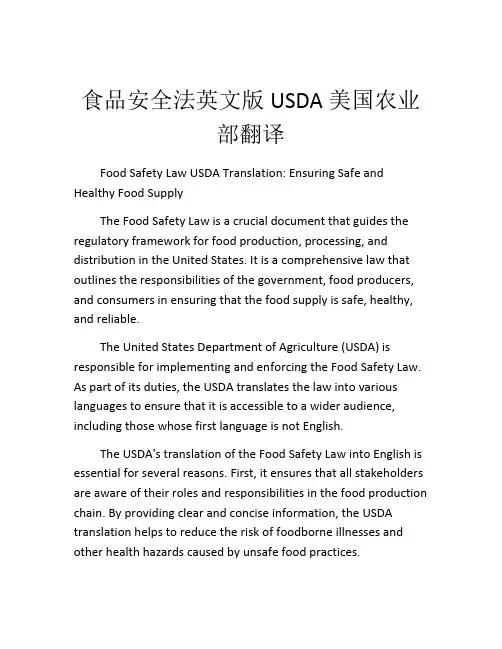
食品安全法英文版USDA美国农业部翻译Food Safety Law USDA Translation: Ensuring Safe and Healthy Food SupplyThe Food Safety Law is a crucial document that guides the regulatory framework for food production, processing, and distribution in the United States. It is a comprehensive law that outlines the responsibilities of the government, food producers, and consumers in ensuring that the food supply is safe, healthy, and reliable.The United States Department of Agriculture (USDA) is responsible for implementing and enforcing the Food Safety Law. As part of its duties, the USDA translates the law into various languages to ensure that it is accessible to a wider audience, including those whose first language is not English.The USDA's translation of the Food Safety Law into English is essential for several reasons. First, it ensures that all stakeholders are aware of their roles and responsibilities in the food production chain. By providing clear and concise information, the USDA translation helps to reduce the risk of foodborne illnesses and other health hazards caused by unsafe food practices.Second, the USDA translation is a valuable tool for food producers as it helps them to understand the regulations and standards they must comply with to ensure that their products are safe for consumption. This is particularly important forsmall-scale producers who may not have the resources to hire legal experts to help them navigate the complex regulations.Third, the USDA translation helps to address the language barrier that can prevent some consumers from accessing critical information regarding food safety. By making the Food Safety Law available in multiple languages, the USDA ensures that all consumers, regardless of their background, can make informed decisions about the food they eat.The Food Safety Law covers a wide range of areas that are critical to ensuring a safe food supply. These include food labeling, inspection, and testing, as well as standards for food additives and contaminants. The law also provides guidelines for the handling and storage of food, as well as regulations relating to food imports and exports.To enforce the Food Safety Law, the USDA works closely with other federal agencies, including the Food and Drug Administration (FDA) and the Centers for Disease Control and Prevention (CDC). The USDA also collaborates with state and local governments, as well as industry groups and consumer organizations, to develop and implement food safety policies and programs.In conclusion, the USDA translation of the Food Safety Law plays a crucial role in ensuring a safe and reliable food supply for all Americans. By providing clear and accessible information, the USDA helps food producers, regulators, and consumers to work together to ensure that the food we eat is healthy, nutritious, and free from harm. As the world continues to grapple with the challenges of food safety, the USDA's translation of the Food Safety Law will remain an indispensable tool in ensuring that our food supply is safe, healthy, and sustainable.。
食品安全英文版
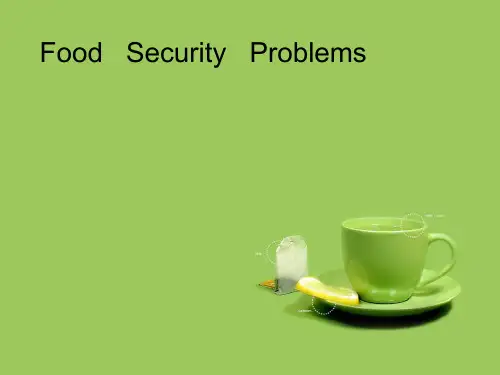
Coca-Cola minute maid fruit grain of milk containing pesticide
November 28, 2011, In chang chun a pair of mother and child drinking coke minute maid fruit grain of milk optimal (pure and fresh strawberry) after the poisoning, including poisoning boy has died. Police identified surplus(剩余的) drinks is extremely toxic pesticides(杀虫 剂). Local has happened since 2 similar events, a total of four people poisoning.
Food Security Problems
What is food safety?
.According to the definition of the World Health Organization,the food safety , is a public health issue in which toxic and hazardous substances in food effect human health.
Meng Niu milk was detected had contained carcinogenic (致癌的)substance
A batch of (一批)Meng niu milk was found to contain excessive levels of flavacin M1 - a substance linked to liver cancer(肝癌), the country's top quality watchdog said over the weekend. The batch did not reach the market, officials said.The Inner Mongolia-based Mengniu Dairy Group yesterday apologized to consumers and said the products involved have been destroyed. Flavacin M1 is found in food mold and can cause severe liver damage, including liver cancer. In 1998, the World Health Organization listed flavacin M1
食品安全英语作文(优秀7篇)
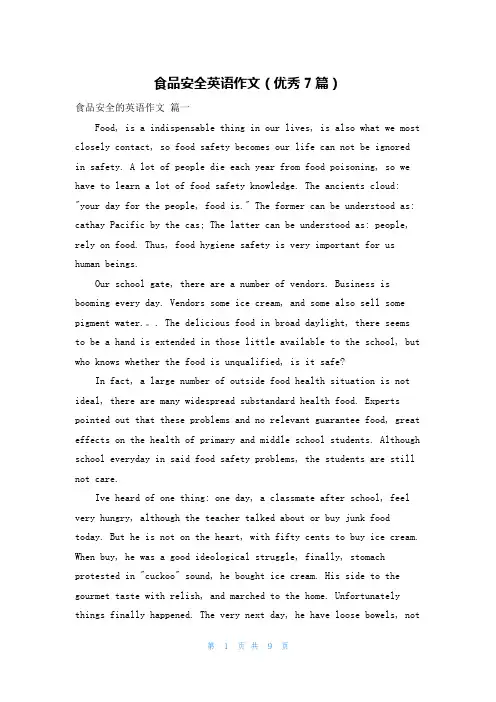
食品安全英语作文(优秀7篇)食品安全的英语作文篇一Food, is a indispensable thing in our lives, is also what we most closely contact, so food safety becomes our life can not be ignored in safety. A lot of people die each year from food poisoning, so we have to learn a lot of food safety knowledge. The ancients cloud: "your day for the people, food is." The former can be understood as: cathay Pacific by the cas; The latter can be understood as: people, rely on food. Thus, food hygiene safety is very important for us human beings.Our school gate, there are a number of vendors. Business is booming every day. Vendors some ice cream, and some also sell some pigment water.。
. The delicious food in broad daylight, there seems to be a hand is extended in those little available to the school, but who knows whether the food is unqualified, is it safe?In fact, a large number of outside food health situation is not ideal, there are many widespread substandard health food. Experts pointed out that these problems and no relevant guarantee food, great effects on the health of primary and middle school students. Although school everyday in said food safety problems, the students are still not care.Ive heard of one thing: one day, a classmate after school, feel very hungry, although the teacher talked about or buy junk food today. But he is not on the heart, with fifty cents to buy ice cream. When buy, he was a good ideological struggle, finally, stomach protested in "cuckoo" sound, he bought ice cream. His side to the gourmet taste with relish, and marched to the home. Unfortunately things finally happened. The very next day, he have loose bowels, notonly themselves, parents also worry! This is not obedient disorderly buy snacks.And in front of our school, there are some only sell 1 dollar soda, are popular among pupils. Body feels very soft, very thin. Soda is divided into coke, orange and lemon flavors. But these cheap soda, is actually some small workshops with essence, pigment and water filling. Impossible to have quality assurance. In addition, soda bottles generally is recycling, their health status is self-evident. Unsafe food events caused great influence to peoples life, food regulators also always attaches great importance to this problem. Believe that relevant departments can seriously, strict management, give you a rest assured food environment. We, as a primary school student, as a member of a society, we should also be constantly improve the self-protection ability and the ego to protect consciousness, render and do our work with regulators.Although these "3 without" food together, have very big allure, for our self-control is not strong, very easy to be tempted. Hope everybody can enhance safety consciousness, safety wake-up call, responsible for ones own body.食物,是我们生活中不可缺少的东西,也是我们接触最密切的东西,所以食品安全就成了我们生活中不可忽视的安全问题。
食品安全英语作文
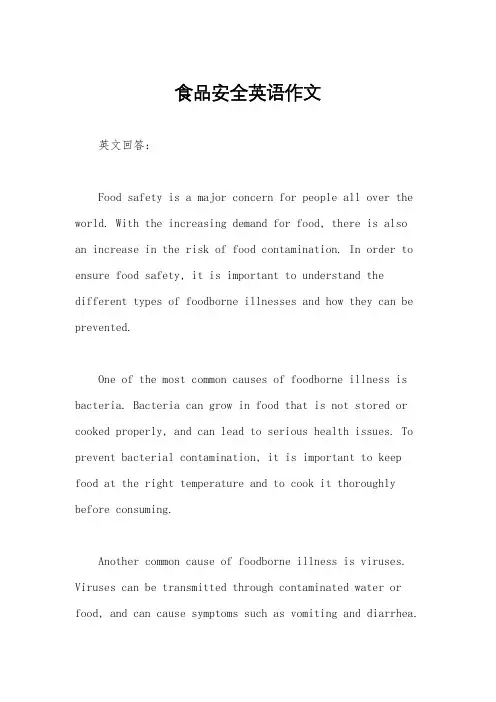
食品安全英语作文英文回答:Food safety is a major concern for people all over the world. With the increasing demand for food, there is also an increase in the risk of food contamination. In order to ensure food safety, it is important to understand the different types of foodborne illnesses and how they can be prevented.One of the most common causes of foodborne illness is bacteria. Bacteria can grow in food that is not stored or cooked properly, and can lead to serious health issues. To prevent bacterial contamination, it is important to keep food at the right temperature and to cook it thoroughly before consuming.Another common cause of foodborne illness is viruses. Viruses can be transmitted through contaminated water or food, and can cause symptoms such as vomiting and diarrhea.To prevent viral contamination, it is important to wash hands frequently and to avoid consuming contaminated foodor water.In addition to bacteria and viruses, there are alsoother types of contaminants that can cause foodborne illness, such as chemicals and toxins. These contaminants can be found in food that has been treated with pesticidesor other chemicals, or in food that has been contaminatedby environmental pollution. To prevent contamination from chemicals and toxins, it is important to choose organic or locally grown food whenever possible.Overall, food safety is a complex issue that requires a combination of education, regulation, and personal responsibility. By understanding the different types of foodborne illness and taking steps to prevent contamination, we can help ensure that the food we eat is safe and healthy.中文回答:食品安全是全球人民关注的重要问题。
食品安全英文参考文献精选
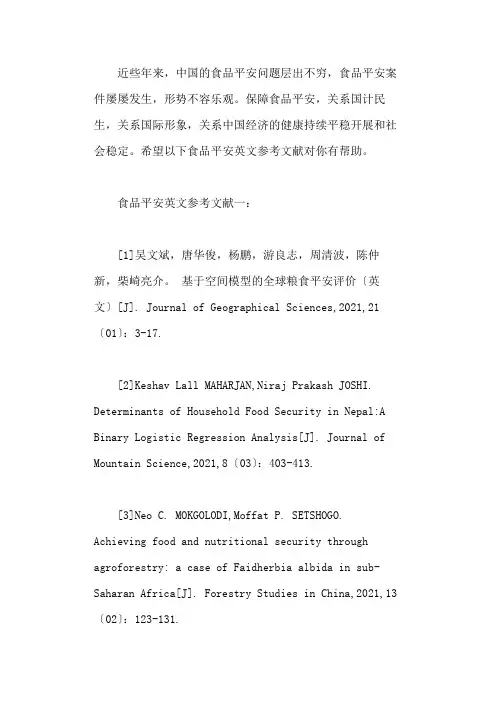
近些年来,中国的食品平安问题层出不穷,食品平安案件屡屡发生,形势不容乐观。
保障食品平安,关系国计民生,关系国际形象,关系中国经济的健康持续平稳开展和社会稳定。
希望以下食品平安英文参考文献对你有帮助。
食品平安英文参考文献一:[1]吴文斌,唐华俊,杨鹏,游良志,周清波,陈仲新,柴崎亮介。
基于空间模型的全球粮食平安评价〔英文〕[J]. Journal of Geographical Sciences,2021,21〔01〕:3-17.[2]Keshav Lall MAHARJAN,Niraj Prakash JOSHI. Determinants of Household Food Security in Nepal:A Binary Logistic Regression Analysis[J]. Journal of Mountain Science,2021,8〔03〕:403-413.[3]Neo C. MOKGOLODI,Moffat P. SETSHOGO. Achieving food and nutritional security through agroforestry: a case of Faidherbia albida in sub-Saharan Africa[J]. Forestry Studies in China,2021,13〔02〕:123-131.[4]. Food Security in the Context of Global Climate Change[J]. Contemporary International Relations,2021,21〔03〕:23-33.[5]. Research of the Farmland Protection Based on Food Security--A Case Study of Anshan City in Liaoning Province, China[J]. Asian Agricultural Research,2021,3〔01〕:93-96.[6]. Problems of Rural Food Safety and Strategies of Constructing Supervision System[J]. Asian Agricultural Research,2021,3〔07〕:54-57+79.[7]. Analysis of Consumers' Willingness to Pay for Traceable Fresh Fruits in Shanghai City and Countermeasures[J]. Asian AgriculturalResearch,2021,3〔12〕:35-38.[8]CAO Yin-gui,BAI Zhong-ke,ZHOU Wei,WANG Jing. Forces Driving Changes in Cultivated Land and Management Countermeasures in the Three GorgesReservoir Area,China[J]. Journal of Mountain Science,2021,10〔01〕:149-162.[9]LU Sha-sha,LIU Yan-sui,LONG Hua-lou,GUANXing-liang. Agricultural Production Structure Optimization: A Case Study of Major Grain Producing Areas, China[J]. Journal of IntegrativeAgriculture,2021,12〔01〕:184-197.[10]Zhijing ZHAO,Xiumin WU. Factors Influencing Food Enterprises' Implementation of ISO9000 Series Standards from the Perspective of Economy and System[J]. Asian Agricultural Research,2021,5〔02〕:7-12.[11]FANG XiuQi,XIAO LingBo,WEI ZhuDeng. Social impacts of the climatic shift around the turn of the 19th century on the North China Plain[J]. Science China〔Earth Sciences〕,2021,56〔06〕:1044-1058.[12]GONG Huili,MENG Dan,LI Xiaojuan,ZHU Feng. Soil Degradation and Food Security Coupled withGlobal Climate Change in Northeastern China[J]. Chinese Geographical Science,2021,23〔05〕:562-573.[13]YUAN Long-ping. Development of Hybrid Rice to Ensure Food Security[J]. Rice Science,2021,21〔01〕:1-2.[14]HUANG Ji-kun,WANG Yang-jie. Financing Sustainable Agriculture Under Climate Change[J]. Journal of Integrative Agriculture,2021,13〔04〕:698-712.[15]Hong LI. Construction of Quality Security and Credibility Mechanism for Chinese Food Enterprises[J]. Asian Agricultural Research,2021,6〔03〕:50-52.[16]Shenggen Fan,Joanna Brzeska. Feeding More People on an Increasingly Fragile Planet: China's Food and Nutrition Security in a National and Global Context[J]. Journal of IntegrativeAgriculture,2021,13〔06〕:1193-1205.[17]Kevin Z.Chen,Claire Hsu. Managing Climate Change Risk in China's Agricultural Sector: The Potential for an Integrated Risk Management Framework[J]. Journal of IntegrativeAgriculture,2021,13〔07〕:1418-1431.[18]SHI Yun,JI Shun-ping,SHAO Xiao-wei,TANG Hua-jun,WU Wen-bin,YANG Peng,ZHANG Yong-jun,Shibasaki Ryosuke. Framework of SAGI Agriculture Remote Sensing and Its Perspectives in Supporting National Food Security[J]. Journal of Integrative Agriculture,2021,13〔07〕:1443-1450.[19]Thomas Li. Food Security Tops Rural Development Tasks[J]. China's Foreign Trade,2021,〔01〕:33.[20]. Toward Food Security[J]. China's Foreign Trade,2021,〔03〕:12-13.[21]. The impacts of biofuels on food securityand supply in China[J]. Engineering Sciences,2021,7〔02〕:52-56+85.[22]Kamran Ismayilov. Food Security in Azerbaijan[J]. China's Foreign Trade,2021,〔19〕:66-67.[23]Shahbaz Khan. Climate change impacts on crop yield,crop water productivity and food security-A review[J]. Progress in Natural Science,2021,19〔12〕:1665-1674.[24]Maliwan NACONSIE,Peng ZHANG. Transgenic technologies in cassava for nutritional improvement and viral disease resistance: a key strategy for food security in Africa[J]. Frontiers ofAgricultural Science and Engineering,2021,3〔04〕:285-294.[25]Vishwambhar Prasad SATI,Lalrinpuia VANGCHHIA. Food security status in rural areas of Mizoram, Northeast India[J]. Journal of MountainScience,2021,14〔04〕:795-805.[26]Aixing Deng,Changqing Chen,Jinfei Feng,Jin Chen,Weijian Zhang. Cropping system innovation for coping with climatic warming in China[J]. The Crop Journal,2021,5〔02〕:136-150.[27]LU Wen-cong,Chen Ning-lu,Qian Wen-xin. Modeling the effects of urbanization on grain production and consumption in China[J]. Journal of Integrative Agriculture,2021,16〔06〕:1393-1405.[28]Jierong WANG,Junying WEI. Study on the Reform of Agricultural Supply Side Based on Food Security[J]. Asian Agricultural Research,2021,9〔04〕:8-10.[29]Linkham Douangsavanh,Anan Polthanee,Roengsak Katawatin. Food Security of Shifting Cultivation Systems: Case Studies from Luang Prabang and Oudomxay Provinces, Lao PDR[J]. Journal of Mountain Science,2006,〔01〕:48-57.[30]. Change of Cultivated Land and Its Implications on Food Security in China[J]. Chinese Geographical Science,2006,〔04〕:299-305.---------------------------------------------------------------------------------------------------------------------------------------------感谢您使用本套资料,您可以根据您的风格和实际情况对本套资料做相应的修改,这样才能变成属于您的东西,切勿完全照抄照搬哦,这样就失去了本套资料存在的初心,相信您在工作和学习路上会一路高歌,完成您最初的梦想。
食品安全英语文献
The Safety of Genetically Modified Food转基因食品的安全Keywords :genetically modified food; advantage; Safety; influence关键词:转基因食品;优势;安全性;影响Abstracts:with the genetically modified food problems become increasingly hot, more and more people begin to pay close attention to genetically modified food,but there also exists considerable controversy about genetically modified food.Genetically modified food has a lot of advantages.But, at the same time its safety is not uncertain,meanwhile it may have much bad influence and harm to human beings and ecological system. 摘要:转基因食品问题变得越来越热,但对转基因食物越来越多的人开始密切关注转基因食品.转基因食品还存在相当大的争议,有很多的很多优势 .但是,在其安全性是不明朗的同时,同时也可能有许多不良影响和危害人类和生态系统。
Introduction:With the rapid growth of the world's population and the decrease of cultivated land, food problem becomes a so hot potato that many countries in the world have to face. If we want to satisfy people's food supply and improve the quality of food Supply, we must rely on science and technology. Nowadays the application of transgenic technology in food production have achieved significant effects. Genetically modified foods is also quietly on people's table.简介:随着快速增长的世界人口和耕地的减少,粮食问题变得如此烫手的山芋,在世界上许多国家不得不面对。
浅谈食品安全英语作文带翻译(5篇)
浅谈食品安全英语作文带翻译(5篇)高中英语写作是是考试的重点,要想考试拿高分,英语作文就应该勤加练习,今天呢,以下是漂亮的小编给家人们收集的浅谈食品安全英语作文带翻译【5篇】,希望对大家有所帮助。
食品安全英语作文篇一Frankly speaking,the great majority of chinese are a bit gluttonous,while unfortunately they have to be trapped in a terrible situation where they could hardly find safe food.They are unable to choose a reassuring milk powder for their baby,and they can’t find a cookshop without using gutter oil,and yes—they are worried about the food safety problems.Why are they so anxious about the food safety problems?Absolutely answer is the problems concern their physical importantly,inability of regulatory authorities to solve the problems makes them more fearful.In my opinion,food safety problem has a significant effect on the social stability.To figure out this matter,government and masses ought to be together in an effort to find ways out.First of all,there must be effective regulations to block the source of profit of the operator like tightening inspection of accounts and taxes.Secondly,treat the masses as a smart inspector.Clean off obstacles and accept the plaints of consumers.At last,the government should hold a press conference periodically to release the progress of governance activities.For above reasons, the food safety problem is a long-term undertaking which needs everyone’s striving.And we must move right now!食品安全的英语作文篇二Over the past couple of years, several cases of the food scandal have been disclosed on various media. The problem of food security has bee a hot button across society. The prevalence of food insecurity has greatly impacted public health, which the government could not afford to ignore, according to the online edition of the People Daily.在过去的几年中,几起食品丑闻案件已经在各种媒体上披露。
食品安全作文 英文
食品安全作文英文英文:Food safety is a very important issue that affects everyone's health. As a consumer, I always pay attention to the safety of the food I eat. There are many factors that can affect food safety, such as the quality of the ingredients, the processing method, and the storage conditions.One of the most common problems with food safety is contamination. This can happen at any stage of the food production process, from the farm to the table. For example, if the water used to irrigate crops is contaminated with harmful bacteria, those bacteria can end up in the food. Similarly, if the equipment used to process food is not properly cleaned and sanitized, it can also lead to contamination.Another issue with food safety is the use of additivesand preservatives. While these substances can help to extend the shelf life of food and improve its taste, they can also be harmful to our health if consumed in large amounts. For example, some preservatives have been linked to cancer and other diseases.As a consumer, there are several things I can do to ensure the safety of the food I eat. First, I always check the expiration date and packaging of the food before buying it. I also try to buy food from reputable sources, such as farmers markets or organic food stores. Additionally, I make sure to properly store and cook the food to minimize the risk of contamination.中文:食品安全是一个非常重要的问题,影响着每个人的健康。
食品科学与工程中英文对照外文翻译文献
1
中文译名 译 文:
ADG 技术:一种新的交替干燥研磨技术加工熟芒果粉
摘要 本文主要研究了熟芒果粉中干燥、研磨交替进行的加工效果。芒果胚乳干燥至不同的 水分含量及其范围。未干燥的芒果和已干燥的芒果相比较,其灰质、果胶、换算总糖分、 淀粉、蛋白质和脂肪含量没有显著性差异。测定了 Bond, Kick 和 Rittinger 研磨常量。 在芒果颗粒干燥前后进行了 X 射线衍射、扫描电镜、差示扫描量热法和红外分析。为了提 高研磨能力,建议采用较低干燥研磨技术加工成熟芒果。提高磨削能力的特征是排除在磨 削过程中的磨削损耗,提高产量,并减小成品的颗粒大小和磨削所消耗的能量。该方法能 够导致分子结构 C-OH 键氧化为 C=O 键应用于成熟芒果加工。
3
2.材料和方法 2.1 芒果抽样程序 成熟的绿色芒果(Manguifera Indica Var Kent)刚收获((来自 Kismathari, Cameroun 的果园中),清洗和允许成熟时期的 15 天在环境温度(20 - 40℃)。一旦成熟,芒果去皮,肉 质胚乳切块(7 毫米厚度,长度 8 厘米,宽度 2 厘米)使用不锈钢刀。 2.2 生物化学分析 新鲜芒果,未干燥的芒果干颗粒进行分析,总还原糖法(Dubois, Gilles, Hamilton, Rebers, & Smith, 1956),水、灰、脂肪和蛋白质(AACC, 1990)、淀粉((AFNOR, 1996, 12), 果胶 (AOAC, 1984, 1884-1984)。 2.3 芒果 ADG(交替干燥和研磨)粉生产过程 新鲜芒果片干 24 h(恒重)电炉烘干机 MEMERT d - 91126(MEMERT, Schwabach, Germany)55℃(Kameni et al., 2003)。批磨的芒果干是 35 s 使用 3.3 AFK SM P 磨床,法 国(12 厘米直径和转速最低 450 tr.每分钟, 装有一把刀破碎机)获得未干燥的芒果颗粒 (UMG)。芒果颗粒分别被干燥 2、6、8 和 14 h 于电炉烘干机 d - 91126 中,在 55℃条件下。 每次干燥时间后,芒果干颗粒(DMG)样本分析含水率和地面 35 s 使用 AFK SM 3.3 P 磨床。 2.4 干燥动力学 芒果干恒重,其含水率确定干燥时间的函数使用美国谷物化学家协会(AACC,1990)。 样品的 重量测量之前和之后在 105℃干燥 3 h 和含水率之间的区别是由干燥前的体重测量,测量后 干燥 100 克样品。 2.5 粒度特征 Djantou et al. (2007)中对粒度特征进行了描述。研磨后,样品颗粒大小是决定使用 标准的筛子筛孔(3 2、1.4、1、1.4、0.4 毫米)堆放在互相最小筛网的筛在底部和顶部的 最大。在每种情况下,样品被放在堆栈顶部屏幕和机械地动摇了 20 分钟(2 毫米范围内,40 kHz 振动频率)。 屏幕保留粒子被移除,重,个人屏幕的质量增量被转换为样本总量的质量分 数。 磨产量确定和代表的比例地面芒果(与最初相比)通过筛子的直径 2 毫米在给定的时间。 L1,表面体积平均直径,“饲料和地面”示例使用方程 质量分数的基础上,在那里,Di 是粒 度和 mi 是质量分数。Bond’s (Work index), Kick’s and Rittinger’s 常量计算后, 方程(1 - 4) (McCabe, Smith, & Harriott, 1993, pp. 960e965)
- 1、下载文档前请自行甄别文档内容的完整性,平台不提供额外的编辑、内容补充、找答案等附加服务。
- 2、"仅部分预览"的文档,不可在线预览部分如存在完整性等问题,可反馈申请退款(可完整预览的文档不适用该条件!)。
- 3、如文档侵犯您的权益,请联系客服反馈,我们会尽快为您处理(人工客服工作时间:9:00-18:30)。
中英文翻译(文档含英文原文和中文翻译)论食品供应链管理和食品质量安全上世纪90年代以来,供应链管理已成为学术界和实业界关注的热门话题,特别是供应链管理成功地应用于IBM、P&G、DELL 等公司的经营管理以后,食品和农产品行业也纷纷效仿并借助供应链管理这一工具来提高自身的竞争力。
1996年,Zuurbier等学者在一般供应链的基础上,首次提出了食品供应链概念,并认为食品供应链管理是农产品和食品生产销售等组织,为了降低食品和农产品物流成本、提高其质量安全和物流服务水平而进行的垂直一体化运作模式。
如今,在美国、英国、加拿大和荷兰等农业生产较为发达的国家,这一管理模式已经广为应用,并逐渐成为当今学术研究的重点课题。
对食品供应链管理的研究大致经历了三个阶段:第一阶段为商流管理阶段,研究范围包括农产品和食品加工企业的产出到消费者消费前的商流阶段,其研究内容通常被包含在营销范畴内;第二阶段为集成物流管理阶段,农产品的物流管理从市场营销中分离出来,且向上游扩展到农产品和食品生产企业的生产加工过程,强调生产应以市场需求为导向和对整个物流环节的成本控制;第三阶段为供应链一体化管理阶段,研究范围进一步向上游延伸到农产品的最上游企业(如种子供应商等),延伸的目的是为了跟踪和追溯农产品食品质量安全问题,以便快速和有效地发现并解决问题。
本文介绍了不同食品供应链的生产物流系统特点,并对食品供应链与食品质量安全管理的发展进行了分析和探讨。
一.食品供应链管理的产生原因近年来,食品供应链的产生和发展是人们对食品消费的要求不断提高的必然结果。
具体而言,产生的原因主要有:(1)消费者对食品和农产品的新鲜度要求越来越高,并要求食品和农产品交货期、生产期越短越好。
(2)消费者对食品和农产品的质量要求也越来越高,迫使食品生产企业实行食品供应链管理,以保证稳定的上游原料供应和下游的销售渠道畅通。
(3)消费者对食品的质量安全也越来越关注。
为了满足消费者对食品和农产品在种类和数量上的要求,企业不断寻求和研发新技术,而新技术和新方法的过度使用(如杀虫剂、激素、抗生素和转基因技术等),在满足了消费者需求的同时,也不可避免地对人体产生了危害从而引起食品质量安全问题。
这是因为市场中买卖双方信息不对称,消费者在购买食品或农产品时,不了解产品的卫生、环保和安全信息。
因此,企业有必要在生产过程的各个环节对产品进行检验和检测并及时向消费者披露这些信息。
(4)食品和农产品企业迫于政府、相关社会组织和消费者的要求和压力,不得不按食品供应链来进行运作。
例如,欧盟管理法规第178号规定,从2004年起在欧盟范围内销售的所有食品,都要实行食品供应链跟踪与追溯;同样在美国,食品与药品管理局规定,在美国国内外从事食品生产、加工和包装等的部门以及相关组织,在2003年12月12日前要向食品与药品管理局进行登记,以便进行食品安全跟踪与追溯,未登记者就不许从事食品生产和销售。
由此可见,食品供应链管理是在市场内在动力和政府外在压力的情况下促成的。
二.食品供应链生产物流系统食品供应链的形成是与其物流系统的内容不断变化密切相关的,特别是在食品和农产品生产物流系统不断演变的情况下,为人们创建高效率的食品供应链管理范式提供了基础。
根据食品和农产品物流的发展阶段,典型的食品供应链可划分为哑铃型、T型、对称型和混合型四种类型。
1.哑铃型食品供应链。
这种类型的食品供应链严格来说是一种准供应链。
它的特点是供应链较短,连接位于两端的交易主体很多,而中间链节少且交易主体也较少,呈现为哑铃型。
由于上游生产者拥有的技术条件较差、产量低和品种少,故上游聚集了为数众多的农产品生产者;同时,由于产品生产地离市场较近且只提供单一农产品,也又使得链中参与交易的主体大多为农产品生产者,他们在市场上进行直接交易,而少有联系生产者和消费者之间的中间商,因此,种植业者直接将食品和农产品销售给消费者。
在发展中国家,特别是靠近城镇地区的蔬菜供应,一般都采用这种类型的供应链。
2.T型食品供应链。
这种类型的食品供应链一般适用于食品和农产品的生产地和销售地相距较远,消费需求差异较大的情况。
由于农产品易腐烂,农产品生产者不可能直接销售自己的产品,需要通过必要的中间商提供服务,如第三方物流、农产品深加工商和批发商等所提供的相应服务。
这种类型的供应链,上游聚集了较多的农产品生产者,而在中游环节对产地生产情况比较了解,又在销售地占有一定渠道优势的销售商却较少。
因此,T型食品供应链的上游种植业者众多,而中下游中间商和销售商较少且集中,供应链的形状呈现为 T型。
与哑铃型食品供应链相比,它的链条较长,食品和农产品的销售表现为间接性和增值服务性。
这种类型的食品供应链在中国较为普遍,在中国农业产业化不发达的地区,由于缺乏一端连接上游农户,另一端联结销售市场、专门从事农产品加工的龙头企业以及相应的中间环节,农产品生产往往和市场需求相脱节。
因此T型食品供应链由于中间环节缺位和低水平的物流运作,易出现上游农户盲目生产而下游农产品销售困难的现象。
3.对称型食品供应链。
随着新兴销售业态的出现,销售渠道日益被大型专业市场和超市所垄断,农产品和食品的传统销售形式也被超市所取代,而且这种趋势越来越明显,同时由于技术水平的提高,农产品生产也趋向于由少数种植商集约经营。
Boselie.D通过对泰国皇家阿荷生鲜超市食品供应链管理的调查发现,曼谷有50%的食品和农产品是在大型超市(如7-11、皇家阿荷、家乐福、Sainsburry和TESCO)售出的。
这些大型超市为了满足市场对农产品品质一致性和供应稳定性的要求,对供应商进行了严格的筛选。
因此,皇家阿荷生鲜超市实施食品供应链管理后,将供应商从原来的250家减少为60家左右,使物流系统更加高效和简洁。
随着上游农产品供应商数目的锐减和超市连锁店的不断扩张,这种食品供应链的上游供应商与下游超市连锁店的数目呈现对称增长之态势。
在发达国家及物流发展较为成熟的大城市里,这种食品供应链经常表现为集中采购、统一流通配送和减少不增值的物流环节,以实现节约成本的精益物流战略。
4.混合型食品供应链。
随着市场食品和农产品消费需求的多样化,食品和农产品加工的比重也在逐步提高。
据有关统计表明,美国2002年度未加工和加工蔬菜的比例为15%和85%;水果为30%和70%。
其他国家的情况也大致如此。
大型超市为了适应消费需求的显著变化,将原先由独立企业从事的专业化生产的增值环节进行“内部化”,专门建立大型加工及配送中心,对农产品进行清洗、分类、深度加工、包装和配送等增值业务,同时通过在大型加工中心实施HACCP 和GMP加工质量和卫生安全认证,来保证食品和农产品的品质安全。
这个环节是前述三个食品供应链中所没有的,这是大型超市和连锁店对市场需求作出快速反应的结果。
随着上游供应商实力和优势的增强,加工中心的部分功能,如清洗、分类和深度加工等环节又向供应商回流,使得加工中心的重点放在处理和不断扩大的农产品数量和种类业务上。
因此,这种食品供应链是一种综合型、多品种、大批量和多频次的混合型供应链体系。
这种食品供应链更关注消费者的满意度,通过加工中心来对市场需求作出快速反应,并实时对农产品和食品进行“量身定制”和深度加工,以实现不同于精益物流的灵捷物流战略。
三.食品供应链跟踪与食品质量安全近年来,由于食品供应链合作的重点由原来的保证供货质量逐步转向加强食品和农产品的质量安全,如疯牛病、口蹄疫和转基因食品等的出现。
农产品和食品质量安全的跟踪离不开食品供应链管理,因此基于质量安全的食品供应链跟踪成了食品供应链管理的重点和难点。
Golan.E等通过对美国生鲜农产品、谷类和油菜以及牛肉制品的调查研究发现,三者经食品供应链跟踪后,在食品质量安全方面出现了很大的差异。
而分析这些差异,他们又发现三种农产品食品供应链管理的共性,即存在三种驱动力。
这也是企业实施食品供应链管理时需要分析考察的问题:1.有利于食品和农产品差别化营销,以提高食品和农产品的销量。
通过那些细小的或不能直接发现的食品质量安全的特性,可区别不同类型的农产品和食品。
因为在食品和农产品市场上不仅存在大量单一的谷类和肉类产品,而且也有根据消费者不同的偏好和口味量身定制的食品。
有些农产品和食品的质量可能容易判别,而另一些则不容易直接判别,甚至在消费之后也不能马上发现其质量问题。
例如,转基因食用油,如未进行标识,消费者就很难判别食用油是否由非转基因大豆加工而成。
因此,对农产品和食品的安全质量和品质进行细分,是差别化营销的必要前提。
2.有利于农产品和食品质量安全的跟踪,减少食品和农产品召回成本。
许多企业已利用食品供应链跟踪系统,来最大限度地减少食品安全体系缺陷可能造成的潜在损失。
供应商通常有着很强的经济驱动性,当发现食品有安全隐患和质量问题时,他们往往会采取措施,避免食品质量安全问题给企业自身或品牌带来负面的影响。
基于食品供应链的跟踪能帮助企业缩短确认和清理有问题食品的时间,为此,国外许多企业将相关标识信息揭示在食品包装上,以便利消费者的识别和认定。
例如,在美国大多数要求召回的食品和农产品都被公布在美国农业部食品安全和检验服务的官方网站上,以便消费者根据食品包装的标识信息来判定有问题的食品和农产品。
有些企业则通过使用先进RSS条码系统和EAN/UCC全球统一标识系统,更为具体地揭示食品供应链的标识信息,如每种产品的种子、施肥、使用抗生素的情况、生产时间、生产线、生产地、生产所使用的技术和生产次序,等等。
因此某种产品一旦出现问题,这些标识信息将能够发挥很大的作用。
目前,欧盟已经采用EAN/UCC系统,成功地开展了对牛肉、蔬菜等食品追踪的研究。
通过采用EAN/UCC-128条码符号、GLN(全球位置码)可以对食品供应链全过程中的产品及其属性信息和参与方信息等进行有效的标识。
在对食品跟踪与追溯时,要求供应链中的每一道加工环节,不仅要对自己所加工完成的产品进行标识,还要采集所需加工的食品原料上的已有标识信息,并将其全部信息标识在加工完成的产品上,以备下一道加工环节或消费者使用,从而有效地解决了供应链各环节之间的联系比较脆弱、实施跟踪和追溯难度大的问题,也为企业减少因缺乏明确信息而将混在优质食品中的劣质食品连同优质食品一同处理的可能性。
3.有利于提高和改善供应方的物流管理。
对于企业来说,管理生产物流和跟踪相关零售信息(如条形码),能帮助企业了解其食品供应链的物流流出状况,以便对供应链上游物流的流入进行有效管理。
特别是有些企业采用了基于质量安全的食品供应链的高新技术追溯系统,如农场主使用电子耳标识和相关数据收集卡来跟踪食品和农产品的免疫记录、健康记录和饲养记录等。
这些食品供应链的信息也能使食品或农产品在市场上获得与其质量相符的价格。
